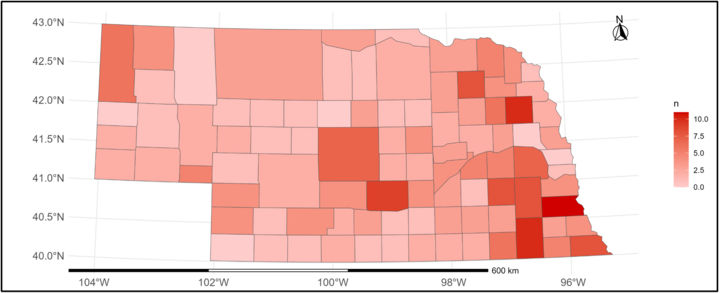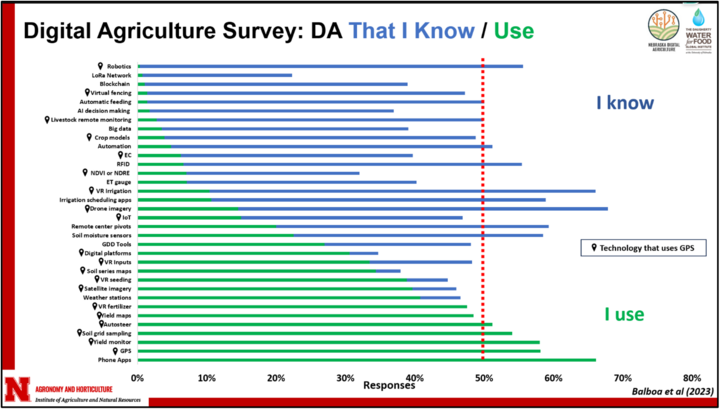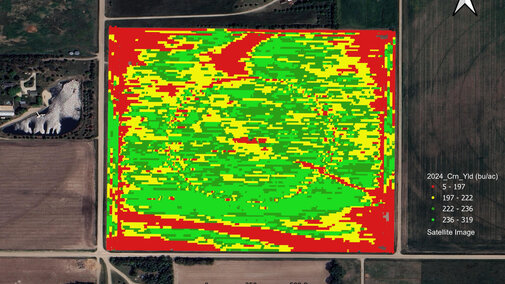This is the second article of CropWatch's digital agriculture series (DA), “How Digital is Agriculture in Nebraska?” See the links below for more.
Articles in this Series:
Part 2: What Digital Tools are Used in Nebraska?
Part 3: Barriers to Adoption of Digital Agriculture in Nebraska
Part 4: Top Five Digital Agriculture Technologies Used in Nebraska
Part 5: DAWN Dashboard: A Decision Support Tool for the Corn Belt
Digital agriculture (DA) can be defined as the use of new technologies, combining multiple data sources and advanced analytical methods integrating systems that allows farmers and stakeholders of the agricultural value chain to improve food production system. Benchmarking the status of digital agriculture in Nebraska is critical to guide the research and extension efforts of the Nebraska Digital Agriculture Team.
This CropWatch article is part two of the digital agriculture series (DA), “How Digital is Agriculture in Nebraska?” If you missed our first article, Ten Facts about Nebraska Digital Ag, we encourage you to read it first, as it discusses the basis of this series. For this study, 2,500 surveys were sent in paper and digital format to Nebraska farmers, and 332 responded. The number of surveys per county was weighted, accounting for the number of farms within each county. The number of responses per county is shown in Figure 1 of the first article. The Ten Facts about Nebraska Digital Ag Flyer summarizes our survey.
In this second article, we focus on what digital tools Nebraska farmers know and what tools they use in their operations. Farmers were asked about 33 technologies that are listed in Figure 2. The survey shows that most of the technologies listed are known by at least 40% of the farmers. The top 10 DA technologies adopted by Nebraska farmers are:
- Phone Apps
- GPS
- Yield Monitor
- Soil Grid Sampling
- Autosteer
- Yield Maps
- Variable Rate Fertilizer
- Weather Station
- Satellite Imagery
- Variable Seeding Rates
The top 10 DA technologies with less adoption by Nebraska farmers (Figure 2) are:
- Robotics
- Lora Network
- Blockchain
- Virtual Fencing
- Automatic Feeding
- Big Data
- Livestock Remote Monitoring
- AI Decision-making
- Crop Models
- Automation

Reviewing the list of technologies in the bottom part of Figure 2, most of them are precision agriculture (PA) technologies that have been for around 25 years. Because of this, precision agriculture is one of the most important branches of digital agriculture. But DA includes IoT (Internet of Things), the use of digital boards, big data analysis, and blockchain, among others. We can observe in Figure 2 that all these technologies have less adoption in Nebraska, although farmers are aware of them.

Technologies related to livestock, cattle and dairy production like virtual fencing, automatic feeding and livestock remote monitoring are relatively know by farmers, but the level of adoption remains low (less than 10%).
In the next CropWatch article for the series “How Digital is Agriculture in Nebraska?”, we will present the barriers identified in our survey that prevent farmers, agronomists and crop consultants from increasing their adoption of DA technologies.
If you want to know more or you have any questions, please contact Dr. Guillermo Balboa.
This project was supported by the Precision Nitrogen Conservation Innovation Grant (CIG—USDA NR203A750013G014). The survey was conducted in cooperation with the UNL Bureau of Sociological Research.
References
Balboa, G.R; Puntel, L; Thompson, L; Paccioretti, P. (2024) Barriers and Adoption of Precision Ag Technologies For Nitrogen Management in Nebraska. XVI International Conference on Precision Agriculture. Manhattan, KS. https://ispag.org/proceedings/?action=download&item=10133
Balboa, G. R., Puntel, L. A., & Thompson, L. (2023) On-Farm Research Network Ecosystem Increased Awareness and Use of Digital Agriculture in Nebraska [Abstract]. ASA, CSSA, SSSA International Annual Meeting, St. Louis, MO. https://scisoc.confex.com/scisoc/2023am/meetingapp.cgi/Paper/150933
Puntel, L. A., Bolfe, É. L., Melchiori, R. J. M., Ortega, R., Tiscornia, G., Roel, A., Scaramuzza, F., Best, S., Berger, A. G., Hansel, D. S. S., Palacios Durán, D., & Balboa, G. R. (2022). How digital is agriculture in a subset of countries from South America? Adoption and limitations. Crop and Pasture Science, 74, 555–572. https://doi.org/10.1071/CP21759

